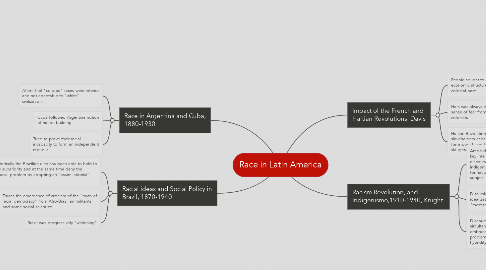Race in Latin America
저자: Gerardo Espinoza Ortiz

1. Race in Argentina and Cuba, 1880-1930
1.1. Affirm that "colored" races were inferior and not adaptable to "white" civilization.
1.2. Cuba followed Argentina notion of nation building.
1.3. Tried to prove their racial incapacity to form an independent republic.
2. Racial ideas and Social Policy in Brazil, 1870-1940
2.1. Argues that historically the Brazilian elite has been able to hold to a belief in white superiority and at the same time deny the existence of a racial problem by adopting an “assimilationist” ideology.
2.2. Traces the emergence of criticism of the “myth of racial democracy” from Afro-Brazilian militants and some social scientists.
2.3. Brazil was progressively “whitening"
3. Impact of the French and Haitian Revolutions, Davis
3.1. People sought to create a different social and economic structure that would break with the colonial past.
3.2. Haiti was always embedded with a sense of fear from the elite white colonists.
3.3. Haitian Revolution reinforced the conviction (of slaveholders especially) that slave emancipation in any form would lead to economic disaster as well as the slaughter of whites.
4. Racism Revolution, and Indigenismo,1910-1940, Knight.
4.1. Article discusses the ideas of several key intellectuals that formed the discourse of indigenismo and its ties to the formation of a national mestizo subject.
4.2. Discursive nature of the idealizations of "mestizo" and "Indian".
4.3. Discourses of indigenismo simultaneously embraced and sustained problematic notions of purity and hybridity.


